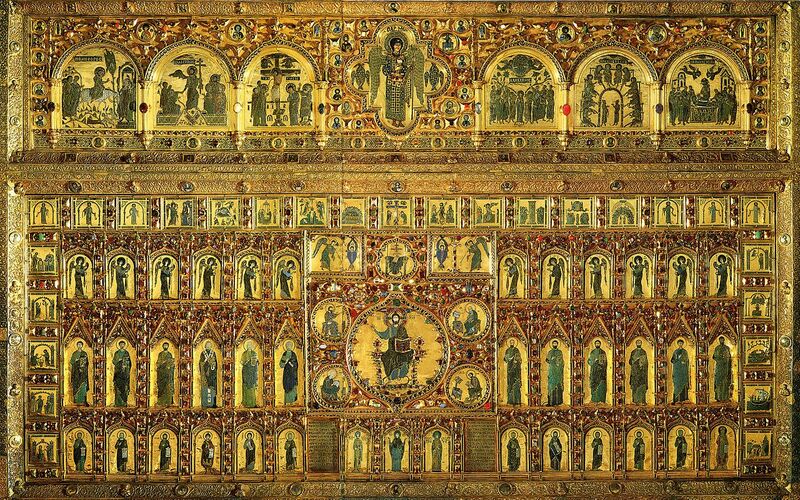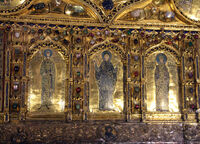Pala d'Oro
Type:
Altarpieces
Date:
1105, with later additions
Location or Findspot (Modern-Day Country):
Italy
Dimensions:
2.1 × 3.5 m
Description:
Ordelafo Falier, the Doge of Venice (r. 1102–1118), commissioned the Pala d'Oro (Italian for Golden Cloth), a golden altarpiece with enamel decoration for the main altar of the Basilica of San Marco, Venice. It was made in Constantinople, possibly to replace an earlier pala from which it took some of its older enamels. Falier, the Virgin Mary, and an empress appear between two fourteenth-century inscription panels (Falier's portrait may have been reworked from the image of a Byzantine official).
The Pala's other images include Christ in Majesty, the four Evangelists, prophets, apostles, angels, deacons, and scenes from the life of St. Mark. Additional scenes from the life of Christ and an image of the archangel Michael were added to the top of the Pala in 1209 (a commission associated with Doge Pietro Ziani). The altar combines both Latin and Greek inscriptions, a simultaneous reflection of patronage and place of production. Post-1209 additions may also reflect enamels taken from Constantinople (possibly from the Pantokrator Monastery) after the Venetians' conquest of the city.
The Pala d'Oro incorporates over eighty Byzantine enamels dating from the tenth to the late twelfth century—a period of flourishing in Byzantine enamel work—as well as later Venetian enamels. The techniques used in these cloisonné enamels revived those from antiquity: Powdered glass (frit) is placed into metal compartments (cloisons) and heated so that it bonds with its metal frame. The powdered glass used to make early medieval enamel often came from old Roman mosaic tesserae, which were traded widely across the Mediterranean world. The size of the cloisonné plaques was limited by the need to maintain a slow, uniform cooling rate after firing.
The Pala's other images include Christ in Majesty, the four Evangelists, prophets, apostles, angels, deacons, and scenes from the life of St. Mark. Additional scenes from the life of Christ and an image of the archangel Michael were added to the top of the Pala in 1209 (a commission associated with Doge Pietro Ziani). The altar combines both Latin and Greek inscriptions, a simultaneous reflection of patronage and place of production. Post-1209 additions may also reflect enamels taken from Constantinople (possibly from the Pantokrator Monastery) after the Venetians' conquest of the city.
The Pala d'Oro incorporates over eighty Byzantine enamels dating from the tenth to the late twelfth century—a period of flourishing in Byzantine enamel work—as well as later Venetian enamels. The techniques used in these cloisonné enamels revived those from antiquity: Powdered glass (frit) is placed into metal compartments (cloisons) and heated so that it bonds with its metal frame. The powdered glass used to make early medieval enamel often came from old Roman mosaic tesserae, which were traded widely across the Mediterranean world. The size of the cloisonné plaques was limited by the need to maintain a slow, uniform cooling rate after firing.
Relevant Textbook Chapter(s):
7,
8
Image Credits:
Wikimedia Commons



